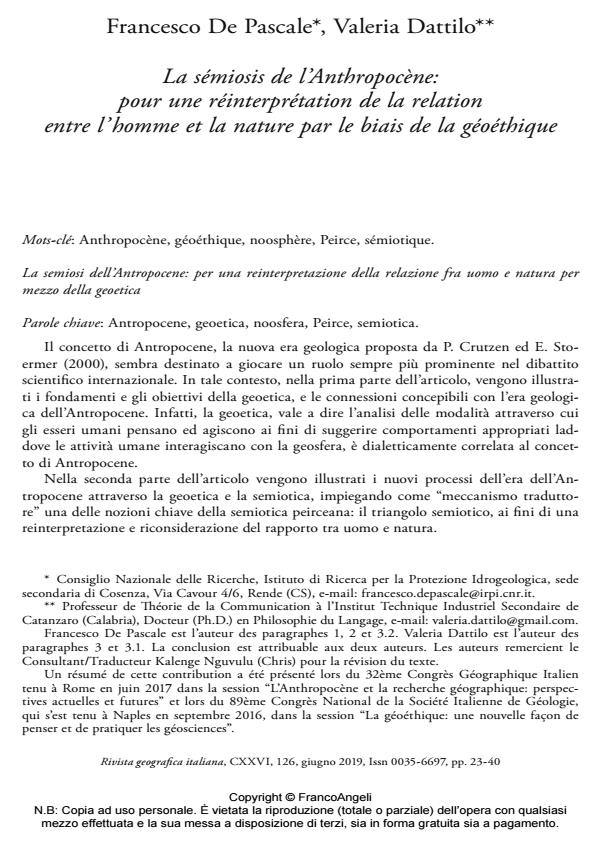The semiosis of the Anthropocene: for a reinterpretation of the relationship between man and nature through geoethics
Journal title RIVISTA GEOGRAFICA ITALIANA
Author/s Francesco De Pascale, Valeria Dattilo
Publishing Year 2019 Issue 2019/2
Language French Pages 18 P. 23-40 File size 144 KB
DOI 10.3280/RGI2019-002002
DOI is like a bar code for intellectual property: to have more infomation
click here
Below, you can see the article first page
If you want to buy this article in PDF format, you can do it, following the instructions to buy download credits

FrancoAngeli is member of Publishers International Linking Association, Inc (PILA), a not-for-profit association which run the CrossRef service enabling links to and from online scholarly content.
The Anthropocene concept, the new geological era proposed by P. Crutzen and E. Stoermer (2000), seems to be meant to play an increasingly prominent role in the international scientific debate. In this context, the first part of the article illustrates the foundations and objectives of geoethics, and the conceivable connections with the Anthropocene geological era. In fact, geoethics, that is the analysis of how humans think and act in order to suggest appropriate behaviors where human activities interact with the geosphere, is dialectically related to the concept of Anthropocene. In the second part of the article the new processes of the Anthropocene era are illustrated through geoethics and semiotics, using as a "translator mechanism" one of the key notions of Peircean semiotics: the semiotic triangle, for the purpose of reinterpreting and reconsidering the relationship between man and nature.
Il concetto di Antropocene, la nuova era geologica proposta da P. Crutzen ed E. Stoermer (2000), sembra destinato a giocare un ruolo sempre più prominente nel dibattito scientifico internazionale. In tale contesto, nella prima parte dell’articolo, vengono illustrati i fondamenti e gli obiettivi della geoetica, e le connessioni concepibili con l’era geologica dell’Antropocene. Infatti, la geoetica, vale a dire l’analisi delle modalità attraverso cui gli esseri umani pensano ed agiscono ai fini di suggerire comportamenti appropriati laddove le attività umane interagiscano con la geosfera, è dialetticamente correlata al concetto di Antropocene. Nella seconda parte dell’articolo vengono illustrati i nuovi processi dell’era dell’Antropocene attraverso la geoetica e la semiotica, impiegando come "meccanismo traduttore" una delle nozioni chiave della semiotica peirceana: il triangolo semiotico, ai fini di una reinterpretazione e riconsiderazione del rapporto tra uomo e natura.
Keywords: Anthropocene, geoethics, noosphere, Peirce, semiotics
- Del rischio e della ripetizione. La comunicazione come azione Valeria Dattilo, in PRISMA Economia - Società - Lavoro 3/2019 pp.30
DOI: 10.3280/PRI2018-003003 - Geoethics for Nudging Human Practices in Times of Pandemics Eduardo Marone, Martin Bohle, in Sustainability /2020 pp.7271
DOI: 10.3390/su12187271 - Geo-societal Narratives Martin Bohle, Eduardo Marone, pp.1 (ISBN:978-3-030-79027-1)
- The Geoethical Semiosis of the Anthropocene: The Peircean Triad for a Reconceptualization of the Relationship between Human Beings and Environment Francesco De Pascale, Valeria Dattilo, in Annals of the American Association of Geographers /2021 pp.647
DOI: 10.1080/24694452.2020.1843994
Francesco De Pascale, Valeria Dattilo, La sémiosis de l’Anthropocène: pour une réinterprétation de la relation entre l’ homme et la nature par le biais de la géoéthique in "RIVISTA GEOGRAFICA ITALIANA" 2/2019, pp 23-40, DOI: 10.3280/RGI2019-002002